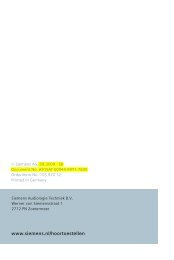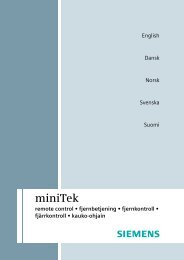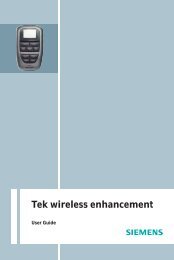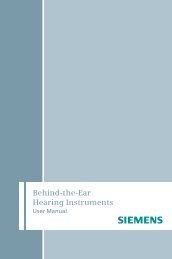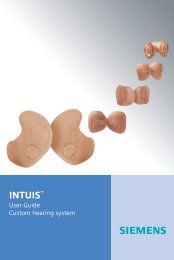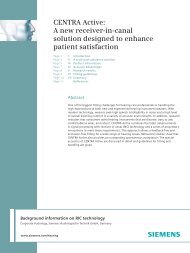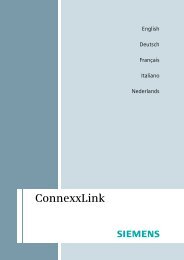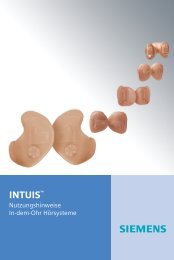Study report SoundSmoothing - Siemens Hearing Instruments
Study report SoundSmoothing - Siemens Hearing Instruments
Study report SoundSmoothing - Siemens Hearing Instruments
You also want an ePaper? Increase the reach of your titles
YUMPU automatically turns print PDFs into web optimized ePapers that Google loves.
www.siemens.com/hearing<br />
<strong>Study</strong> <strong>report</strong><br />
<strong>SoundSmoothing</strong><br />
Despite such modern features as multichannel, wide dynamic range compression (WDRC),<br />
output limiting and noise suppression, many hearing instrument users still <strong>report</strong> discomfort<br />
from common transient noises like paper rustling or clattering dishes (Hernandez et al., 2006).<br />
In keeping with the company‘s innovative, user-oriented philosophy, <strong>Siemens</strong> has developed<br />
<strong>SoundSmoothing</strong>®, an algorithm that substantially reduces impulsive, non-speech sounds. Recently,<br />
the National Acoustic Laboratories (Australia) conducted an interesting and significant<br />
clinical study to evaluate the effects of this new algorithm (O'Brien et al., 2006).<br />
<strong>SoundSmoothing</strong>: How it works<br />
After a spectro-temporal analysis of the microphone signal, envelope features are extracted. These<br />
are then used to determine whether speech or non-speech sounds are present. To accomplish<br />
this, the envelope features are analyzed using a speech model. Then an attenuation factor is<br />
calculated for non-speech sounds only. The amount of transient gain modification is determined<br />
by the ratio of peak level to long-term overall RMS level (i.e. the more transient, the more gain<br />
reduction).<br />
Fig. 1 Algorithmic implementation of <strong>SoundSmoothing</strong><br />
Objectives<br />
The objectives of this study were to determine if:<br />
• <strong>SoundSmoothing</strong> provides a noticeable benefit to hearing aid users when listening to<br />
transient noises.<br />
• <strong>SoundSmoothing</strong> negatively affects speech perception and / or the horizontal localization<br />
of sounds containing transients.<br />
Evaluation of a transient noise reduction algorithm<br />
Josef Chalupper and Beate Krämer<br />
Corporate Audiology, <strong>Siemens</strong> Audiologische Technik GmbH, Germany<br />
Speech model<br />
Input Spectro-temporal Extraction<br />
Detection Transient gain Resynthesis Output<br />
analysis<br />
of envelope of non-speech modification<br />
features<br />
components
Methods<br />
21 hearing-impaired subjects ranging in age from 24<br />
to 85 years, with a median age of 75, participated in<br />
the study. All subjects had a symmetrical sensorineural<br />
hearing loss. The mean three-frequency average<br />
(3FA) hearing loss of the group ranged from 26 to<br />
58 dB HL, with a mean 3FA of 43 dB HL. The subjects<br />
had worn amplification devices from 1.5 to 21 years,<br />
with a mean of 7.5 years. All subjects were fitted<br />
binaurally with CENTRA P BTE housings containing<br />
microphones and receivers. The signal processing<br />
was done in an external computer. The devices were<br />
fitted according to NAL-RP (Byrne et al.1991). Linear<br />
amplification was chosen to separate the effect of<br />
<strong>SoundSmoothing</strong> from other signal processing strategies<br />
that adaptively change gain.<br />
The <strong>SoundSmoothing</strong> algorithm could be disabled or<br />
enabled on three strengths: minimum, medium, and<br />
maximum. The algorithm was evaluated using six<br />
stimuli comprising:<br />
• Speech within two loud, repeated transient<br />
sounds (door slamming and hammering nails)<br />
• Speech within two softer sounds with frequent<br />
amplitude fluctuations (paper rustling and cutlery<br />
clattering)<br />
• Speech within a medium level of stationary<br />
sounds (party noise)<br />
• Speech in quiet surroundings<br />
In a round-robin paired-comparison test, the three<br />
strengths and the “off” condition were compared<br />
five times for speech in the door slamming, paper<br />
rustling and quiet stimuli. For the remaining stimuli<br />
only the medium strength and the ”off” condition<br />
were compared. Each comparison was rated in terms<br />
of preference strength (slightly better, moderately<br />
better, or much better). For each stimulus, the<br />
subjects were asked to indicate what subjective<br />
listening criteria they had used to determine their<br />
preference.<br />
Horizontal localization performance was measured<br />
using the hammering nails noise as stimulus. Horizontal<br />
testing was conducted in an anechoic chamber<br />
with an array of 20 loudspeakers. A 1.5-second<br />
sample of the hammering nails noise was used as<br />
the test stimulus. The subjects were asked to verbally<br />
<strong>report</strong> the perceived direction of the stimuli.<br />
”A strong preference for<br />
<strong>SoundSmoothing</strong> can be seen<br />
for all impulsive noises.“<br />
Speech recognition was measured in the more continuous<br />
paper rustling and cutlery clattering noises.<br />
All three strengths as well as the ”off” condition<br />
were included in these tests. For the speech discrimination<br />
task, the Bamford-Kowal-Bench/Australian<br />
version (BKB/A) Standard Sentence Lists (Bench et al.<br />
1979) were administered.<br />
Prior to testing, the subjects were asked to what extent<br />
they were bothered by sudden sounds in their<br />
everyday lives.<br />
Results<br />
Preference for <strong>SoundSmoothing</strong><br />
For simplification, the results of the various Sound-<br />
Smoothing strengths were combined for each stimuli<br />
– i.e. “on” setting comprises “min”, “med” and “max”.<br />
A strong preference for <strong>SoundSmoothing</strong> can be<br />
seen for all impulsive noises, especially for the loud<br />
and repeated ones (hammering, door slamming).<br />
A two-sided binomial test revealed statistically significant<br />
preference for <strong>SoundSmoothing</strong> “on“ for<br />
hammering (p < 0.001), door slamming (p = 0.007)<br />
and paper rustling (p = 0.002). No preference can<br />
be seen for the stationary party noise and the speech<br />
signals. This is probably due to the fact that<br />
<strong>SoundSmoothing</strong> does not affect these signals and<br />
therefore the subjects did not hear any difference<br />
between the “on” and “off” condition, yet the test<br />
conditions forced the participants to choose between<br />
them. Nevertheless, this is a very positive finding, as<br />
it confirms that <strong>SoundSmoothing</strong> does not cause any<br />
artifacts or interferences that would reduce speech<br />
quality. Generally, the subjects used clarity of speech<br />
as their main listening criterion in the paired comparison<br />
test, although loudness and comfort of noise<br />
rated higher (or equally high) when listening to<br />
speech in the three most transient noises (door slamming,<br />
hammering nails, and cutlery clattering).<br />
Repeated measures ANOVAs on the weighted pairedcomparison<br />
preference scores were calculated for<br />
each stimulus, using grouping of the subjects by how<br />
bothersome they found sudden sounds as the between-subject<br />
variable. These analyses revealed no<br />
significant effect of bothersomeness (p > 0.05). This<br />
indicates that the degree to which sudden sounds<br />
bother subjects in their everyday life is not a good<br />
predictor of whether or not they will prefer Sound-<br />
Smoothing for the stimuli used in the present study.<br />
Horizontal localization<br />
Horizontal localization was tested with the conditions<br />
<strong>SoundSmoothing</strong> “on”, “off” and also with 10<br />
hearing-impaired subjects in an unaided condition<br />
(Keidser et al., 2006). The subjects <strong>report</strong>ed no significant<br />
effect of <strong>SoundSmoothing</strong> on horizontal<br />
localization performance in the left/right dimension<br />
(p = 0.33) or in the front/back dimension (p = 0.44).
Fig. 2 Preference for <strong>SoundSmoothing</strong><br />
Preference / %<br />
100<br />
80<br />
60<br />
40<br />
20<br />
0<br />
Hammering Door<br />
slamming<br />
Fig. 3 Speech intelligibility in<br />
noise with <strong>SoundSmoothing</strong><br />
SRT / dB SNR<br />
0<br />
-1<br />
-2<br />
-3<br />
-4<br />
-5<br />
-6<br />
-7<br />
-8<br />
-9<br />
-10<br />
Paper<br />
<strong>SoundSmoothing</strong> off<br />
<strong>SoundSmoothing</strong> min<br />
<strong>SoundSmoothing</strong> med<br />
<strong>SoundSmoothing</strong> max<br />
Cutlery<br />
Paper<br />
rustling<br />
Mean and 95% confidence intervals of speech reception<br />
threshold (SRT); research conducted at the National Acoustic<br />
Laboratories, Australia<br />
<strong>SoundSmoothing</strong> "on" <strong>SoundSmoothing</strong> "off"<br />
Cutlery<br />
clattering<br />
Speech Party<br />
noise<br />
Speech recognition<br />
Speech discrimination testing was conducted in the<br />
same anechoic chamber used for horizontal localization<br />
testing, as described above.<br />
The mean and 95% confidence intervals are shown<br />
in Figure 3. The subjects needed a more favorable<br />
(although still negative) signal-to-noise ratio to understand<br />
50% of the speech signal in paper rustling<br />
noise than in cutlery clattering noise. Analyses of variance<br />
were performed on the signal-to-noise ratios<br />
obtained for each noise using the <strong>SoundSmoothing</strong><br />
setting as a variable. There was no significant effect<br />
of <strong>SoundSmoothing</strong> on speech recognition in paper<br />
rustling (p = 0.65) or cutlery clattering (p = 0.97)<br />
noises.<br />
Percent of participants preferring<br />
<strong>SoundSmoothing</strong><br />
”on” versus ”off” for<br />
different sound samples<br />
using a paired-comparison<br />
procedure; research<br />
conducted at the National<br />
Acoustic Laboratories,<br />
Australia
Conclusions<br />
Although <strong>SoundSmoothing</strong> has its greatest effect on transient sounds with a high input level like door<br />
slamming or hammering, the subjects preferred <strong>SoundSmoothing</strong> “on” for all transient noises, including<br />
softer sounds with a frequent amplitude fluctuation (e.g. paper rustling, cutlery). There were absolutely no<br />
indications that <strong>SoundSmoothing</strong> has any negative effects on speech recognition or localization. The new<br />
CENTRA products are the first hearing instruments to be equipped with <strong>SoundSmoothing</strong>. It is expected that<br />
<strong>SoundSmoothing</strong> will soon be a standard feature in many high-end hearing instruments.<br />
References<br />
O‘Brien, A., Keidser, G., Convery, E., Dillon, H. (2006).<br />
Evaluation of a transient noise reduction algorithm.<br />
NAL internal <strong>report</strong>: NAL011.<br />
Hernandez, A. R., Chalupper, J., Powers, T. A. (2006).<br />
An assessment of everyday noises and their annoyance.<br />
The <strong>Hearing</strong> Review, 13(7), 16–20.<br />
Bench, R. J., Doyle, J., Daly, N., Lind, C. (1979).<br />
The BKB/A Speechreading (Lipreading) Test.<br />
Victoria: La Trobe University.<br />
Byrne, D., Parkinson, A., Newall, P., in:<br />
Studebaker, G. A., Bess, F. H., and Beck, L. editors. (1991).<br />
Modified hearing aid selection procedures for severe/profound<br />
hearing losses: Parkton, MD.<br />
York Press. p. 295–300.<br />
Keidser, G., Rohrseitz, K., Dillon, H., Hamacher, V.,<br />
Carter, L., Rass, U., Convery, E. (2006).<br />
The effect of multi-channel wide dynamic range compression,<br />
noise reduction, and directional microphone on horizontal<br />
localisation performance in hearing aid wearers.<br />
Int J Audiol., in press.<br />
<strong>Siemens</strong> Audiologische Technik GmbH (2006).<br />
<strong>SoundSmoothing</strong>: A new algorithm to reduce the annoyance<br />
of noise.<br />
<strong>Siemens</strong><br />
Audiologische Technik GmbH<br />
Gebbertstrasse 125<br />
91058 Erlangen<br />
Germany<br />
Phone +49 (9131) 308-0<br />
www.siemens.com/hearing




